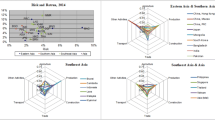Abstract
The idea of this paper is to apply modern portfolio theory to the gross value added shares of different economic activities in order to determine whether or not industry portfolios are efficient. Using the national accounts (Volkswirtschaftliche Gesamtrechnung) of Germany’s federal states for 2011, I run numerical simulations of their gross value added shares to determine the set of “efficient mean-variance combinations” (Markowitz, J Financ 7:77–91, 1952) of economic activities for each German federal state. The paper finds that their 2011 industry portfolios are in fact not efficient, and that rearranging the shares of economic activities increase total gross value added and decrease its risk. According to the numerical results, German federal states—at least Western Germany—could move from industrial to knowledge-based trading and service economies. The results are robust for different sample periods of Germany’s national accounts and the underlying assumptions of the numerical simulations are confirmed by using a sample of EU countries.
Zusammnfassung
Der Artikel überträgt die moderne Portfoliotheorie auf die Bruttowertschöpfung der Wirtschaftszweige in den Ländern der Bundesrepublik Deutschland und deren Branchenstrukturen. Anhand der Daten der volkswirtschaftlichen Gesamtrechnung (VGR) werden zunächst die „effizienten Mittelwert-Varianz Kombinationen“ nach Markowitz (1952) berechnet, um anschließend die Effizienz der Branchenstrukturen von 2011 in den deutschen Bundesländern zu untersuchen. Die numerischen Simulationen zeigen, dass deren Branchenstrukturen nicht effizient sind und eine Umstrukturierung der Anteile der Wirtschaftszweige an der Bruttowertschöpfung zu mehr regionalem Wachstum und Stabilität führt. Dies könnte durch einen Übergang von Industriegesellschaften zu wissensbasierten Handels- und Dienstleistungsgesellschaften in allen Bundesländern – insbesondere in den westdeutschen Flächenländern – erfolgen. Die Ergebnisse sind robust für unterschiedliche Zeiträume der VGR. Eine Stichprobe von EU-Ländern bestätigt darüber hinaus die zugrunde liegenden Annahmen der numerischen Simulationen.





Similar content being viewed by others
Notes
Using real GDP data from Eurostat (2014), annual real growth rates for the EU-28 countries decreased from 3.1 % in 2007 to − 4.4 % in 2009 and after recovering to 1.7 % in 2011 fell again to 0.3 % in 2013.
According to the nomenclature of units for territorial statistics (NUTS) by the EU, German federal states are at the NUTS-1 level.
Technically, I calculate the efficient frontier for each combination (out of five economic activities; starting with a weight of 100 % for one sector) by 1 percentage point steps and record their risk-return characteristics. I then eliminate those with an unfavorable risk for each return (out of the predetermined return range of 0–10 %; starting with a return of 0 %) by 0.01 percentage point steps. Numerical simulations are carried out by the use of the GAUSS matrix programming: http://www.aptech.com/products/gauss-mathematical-and-statistical-system/.
Table 3 in the appendix gives an overview of the VGR nomenclature of economic activities and their abbreviations.
Since the sector “agriculture” contributes only a small proportion of Germany’s gross value added and its shares cannot be altered (or at least increased) significantly, I omit the sector and set its shares to zero. Thus, industry portfolios of the federal states on the efficient frontier are characterized by a maximum of five out of six sectors (n = 5).
Testing of the null hypothesis of “homogeneity of variances” using two 10-year interval for the period 1990–2009 lead to almost the same results.
Table 10 in the appendix shows in addition the average gross value added change for three 5-year intervals and the entire 1996–2010 period.
References
Baldwin RE et al (2003) Economic geography and public policy. Princeton University Press, Princeton
Baldwin RE, Krugman PR (2004) Agglomeration, integration and tax harmonization. Europ Econ Rev 48(1):1–23
Barth J, Kraft J, West P (1975) A portfolio theoretical approach to industrial diversification and regional employment. J Reg Sci 15(1):9–15
Bigerna S (2013) The regional growth-instability frontier in Italy. Atlantic Econ J 41(4):463–464
Board J, Sutcliffe C (1991) Risk and income tradeoffs in regional policy: a portfolio theoretic approach. J Reg Sci 31(2):191–210
Chandra S (2002) A test of the regional growth-instability frontier using state data. Land Econ 78(3):442–462
Chandra S (2003) Regional economy size and the growth-instability frontier: evidence from Europe. J Reg Sci 43(1):95–122
Conroy ME (1974) Alternative strategies for regional industrial Diversification. J Reg Sci 14(1):31–46
Conroy ME (1975) The concept and measurement of regional industrial diversification. Southern Econ J 41(3):492–505
Eurostat (2014) Reale BIP-Wachstumsrate. http://ec.europa.eu/eurostat/tgm/table.do?tab=table&init=1&language=en&pcode=tec00115&plugin=1. Accessed 15 Oct 2015
Ezcurra R (2011) Unemployment volatility and regional specialization in the European Union. Reg Stud 45(8):1121–1137
Ezcurra R, Rios V (2015) Volatility and regional growth in europe: does space matter? Spatial Econ Anal 10(3):344–368
Kluge J (2015) Sectoral diversification as insurance against economic instability. ifo working paper No. 216
Lande PS (1994) Regional industrial structure and economic growth and instability. J Reg Sci 34(3):343–360
Markowitz H (1952) Portfolio selection. J Financ 7(1):77–91
Ramey G, Ramey VA (1995) Cross–country evidence on the link between volatility and growth. Amer Econ Rev 85(5):1138–1151
Sharpe W (1963) A simplified model for portfolio analysis. Manage Sci 9(2):277–293
Siegel PB, Johnson TG, Alwang J (1995) Regional economic diversity and diversification. Growth Change 26(2):261–284
Tobin J (1958) Liquidity preference as behavior towards risk. Rev Econ Stud 25(1):65–86
Volkswirtschaftliche Gesamtrechnungen der Länder VGRdL (2014) Bruttoinlandsprodukt, Bruttowertschöpfung in den Ländern der Bundesrepublik Deutschland 1991 bis 2013 (Berechnungstand: August 2013/Februar 2014), Reihe1, Länderergebnisse Band 1. Statistische Ämter des Bundes und der Länder
World Bank (2013) World Development Indicators. The World Bank. http://data.worldbank.org/indicator. Accessed 15 Oct 2015
Author information
Authors and Affiliations
Corresponding author
Additional information
This paper has benefited greatly from the comments of Jörn Kleinert and three anonymous referees. I am grateful to Uwe Behringer for his efforts on a previous version. I am, of course, responsible for any errors.
Appendix
Appendix
Rights and permissions
About this article
Cite this article
Hafner, K.A. Regional industrial diversification: evidence from German gross value added. Rev Reg Res 36, 169–193 (2016). https://doi.org/10.1007/s10037-016-0105-4
Received:
Accepted:
Published:
Issue Date:
DOI: https://doi.org/10.1007/s10037-016-0105-4





